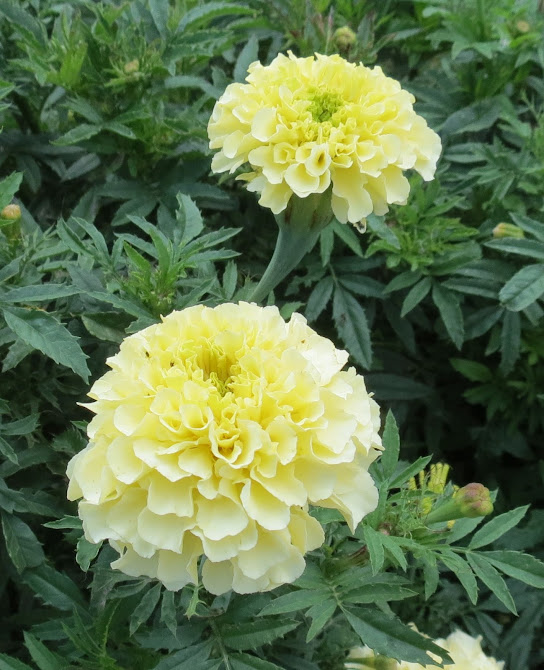Marigolds are such a useful annual. They are tough, colorful, long lasting and attractive to pollinators. They are deer resistant (which doesn't mean deer proof) and their one natural predator is the slug. They are a staple in my garden and landscape each year. They are easy to find in the nurseries, and easy to grow from seed. You can start them early or direct sow them. They are equally happy in the ground or in containers. They come in a wide range of colors, heights and forms.
Marigolds are native to Africa and South America and are now grown worldwide with the English (Calendula) Marigolds differing most from the original form. They naturally come in a palette of oranges and yellows, but in recent years breeders have created more versatile shades. David Burpee began breeding them in the 1920s and is probably primarily responsible for their popularity in America.
"All his life, Burpee has been devoted to the task of making a better marigold. As chief of the W. Atlee Burpee mail-order seed company from 1915 to 1970, Burpee found ways to invent new varieties large and small, but his main quest was for a pure white marigold, one that could be cross-pollinated with existing yellow, orange, and rust varieties to create a rainbow of new colors. In 1954, Burpee made a public offer of $10,000 for seeds that would produce a white blossom at least 2½ in. across. Amateur gardeners sent in thousands of entries, and the Burpee Co. spent $250,000 in testing them, in vain."
Source: Time Magazine
In 1974 Alice Vonk, the widow of an Iowa farmer, finally collected the $10,000 prize and the Snowbird Marigold was born. "Taking into account the contest costs, the prizes, and the development of the "Snowbird", that marigold was the world's costliest flower, but David Burpee considered the money well spent. Never had so many gardens across America been planted with marigolds."
One of my favorite Marigolds is the Vanilla, but this year I tried Snowball which was almost as good. The downside to the white Marigolds is that they are F1 hybrids and saving seeds from them isn't a satisfying experiment. You get all kinds of weird forms.
The Strawberry Blonde is another newer colored Marigold.
They are supposed to be bicolor pastel pink, rose and yellow blooms, but I would describe them more as terracotta. They do change color as the bloom ages which is fun and interesting.
Cool temperatures at the end of summer bring out the rosey hues.
Most Marigolds are a compact, sturdy plants that make a nice border edge.
Pollinators love them and the male bumble bees like to sleep on them at night. I suppose they see them as big cushy mattresses.
Butterflies seem to like them as well as Bumbles and Honey Bees.
 |
| Vanilla Hybrid |
 |
| Disco Mix |
 |
| Fireball Red |
 |
| Durango Outback Mix |
Next to the white Vanilla or Snowball marigolds, my favorite is the Durango Outback mix. In particular, the red and yellow color they call "Bolero". These are easy to start from seed and can be direct sown. Whether you need a plant that is four inches high or four feet high, the Marigold has something to offer.
Next year I will be growing Vanilla, Strawberry Blonde, Fireball, and Durango Mix. I plan on starting some from seed at a later date so they will be ready to go into containers in autumn as a substitute for Mums. Their blooms last so much longer and the colors are perfect for fall.











My favorite is the common, humble, plain old yellow marigold. However, that Durango Mix has my eye now! Thanks!
ReplyDelete--Melanie
Yes, I love the yellow ones. But the yellow with red is so bright and fun! I am not a fan of the plain ole orange
DeleteI love marigolds and yours are gorgeous. So helpful in the garden too!
ReplyDelete